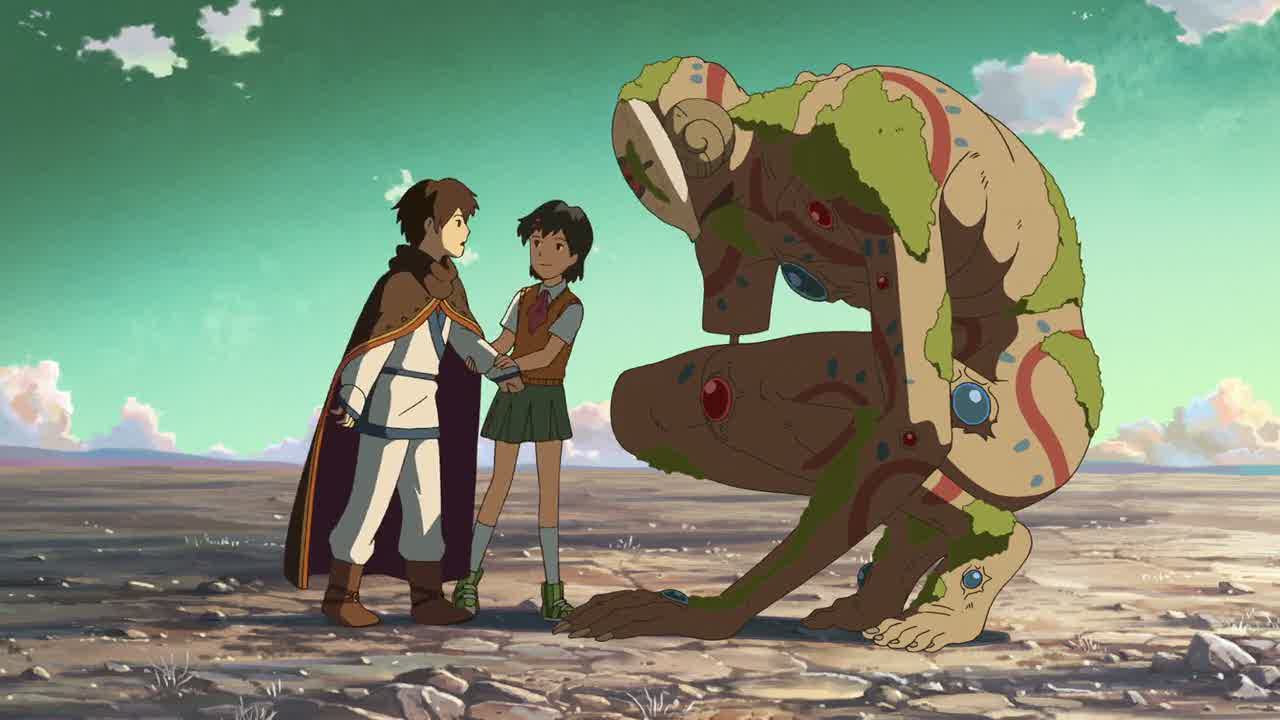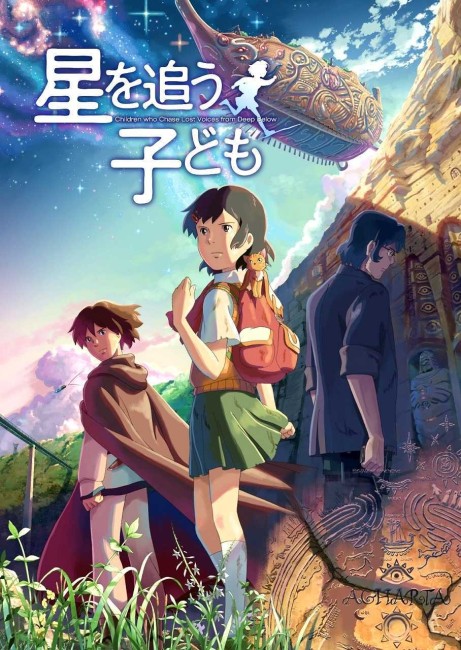aka Children Who Chase Lost Voices
(Hoshi o Ou Kodomo)
Japan. 2011.
Crew
Director/Screenplay/Photography – Makoto Shinkai, Producers – Noritaka Kawaguchi & Makoto Shinkai, Music – Tenmon, Animation Director – Takayo Nishimura, Art Direction – Takumi Tanji. Production Company – Makoto Shinkai/CMW.
Plot
Asuna Watase is a schoolgirl who mostly makes do with life on her own with her father dead and her mother always working. One day she is menaced by a strange giant creature on a railway bridge but is saved by a youth Shun. He is wounded in the process of fending off the creature but she tends him. A friendship grows between the two and he tells her he comes from a place called Agartha. In school, the new teacher Mr Moriaki tells the stories of the underworld in all cultures and Asuna is startled when one of the places he mentions is Agartha. She is then saddened to learn that Shun has been killed. Later she is approached by someone resembling Shun, discovering that this is his brother Shin. Pursued by military forces seeking the crystal clavis he holds, Shin takes them deep down through the caves in the mountainside to the entrance of Agartha. Their lead pursuer follows, revealing that he is Mr Moriaki. Moriaki joins them as they open the gate to the underworld, he determined to enter Agartha to bring his wife back from the dead. Travelling though the land together, Asuna and Moriaki find Agartha a strange and wondrous place. However, their presence is not welcomed by the locals. Shin and others are despatched to be rid of them. Against all advice, Moraiki struggles to find his way to the Gate of Life and Death and be reunited with his wife.
Makoto Shinkai is a rising name in Japanese anime. Shinkai’s first work was the 25-minute long Voices of a Distant Star (2002) about interstellar email communication. This was followed by the full length The Place Promised in Our Early Days (2004) set in an alternate world Japan and 5 Centimetres Per Second (2007) about a friendship between two people over the years. Subsequent to this, Shinkai has made the feature-length likes of The Garden of Words (2013), the cross-temporal bodyswap fantasy Your Name. (2016), Weathering With You (2019) about a girl who can control the weather and the portal fantasy Suzume (2022).
Makoto Shinkai has frequently been compared to Hayao Miyazaki. It is not an inapt comparison for the two have a very similar style – the same plain ligne claire artwork; the focus on the simplicity and ordinariness of the characters and their lives; the reverence and beauty of nature surrounding them; the magical intrusion of the fantastical. There are many points where Children Who Chase Lost Voices from the Deep could be seen to be intersecting with elements from Hayao Miyazaki’s work – the initial venture down into the lost world of Agartha, all ruined entrances and the broken, overgrown splendour of a lost civilisation is reminiscent of Laputa: Castle in the Sky (1986), while the young girl discovering a world filled with strange creatures recalls both My Neighbor Totoro (1988) and in particular the journey into the afterworld of Spirited Away (2001).

Children Who Chase Lost Voices from the Deep is a beautifully made film. Within the first few moments, Makoto Shinkai is wowing us with the exquisiteness of his animation – gorgeously rendered lanes of falling blossoms; the scenes of Asuna walking through the countryside, accompanied by her tiny kitty; of she and Shun watching the sun go down and the shadow move across the valley; tiny insects gathered on branches; the simplicity of the scenes with her at home cooking or folding linen as the cat keeps toppling it – all of which has a beauty that almost bring tears to the eyes. Shinkai generates incredibly tender emotions – the heart-rending flashback scene where the younger Asuna accompanies her mother to the graveside of her father and realises “He’s not coming back is he?”
The encounter with the first Quetzal Coatl on the bridge has the fear and wonderment that is pure Miyazaki. The venture down into the entrance of Agartha, the opening of the gate and especially the wandering through the foliage-covered ruins and Asuna and Moriaki’s dive down into the depths holds an immense awe-filled thrill to it.
Up until this point, Children Who Chase Lost Voices from the Deep is shaping up to be a five star film up alongside the best of Miyazaki. Unfortunately, once it reaches Agartha, the film slows right down. The build-up through the first half has given the impression the film is going to be akin to a version of the Greek myth of Orpheus and the underworld but to then get a journey through an ordinary pastoral fantasy landscape seems anticlimactic.

Moreover, where the film should get exiting – and where Miyazaki would have tightened the pace considerably – Makoto Shinkai proceeds at the same laidback contemplative pace with which the early scenes take place. There seem many elements that could build towards an epic fantasy – Shin’s assignment to find the interlopers, others setting out after them, the threat of the Izouka, Mr Moriaki’s ruthless quest – but Shinkai seems leisurely in terms of bringing them to a dramatic boil.
It is also confusing who exactly the boy that accompanies Asuna down in Agartha – it is said to be the brother Shin but at other points, the film confuses him with his brother Shun. Moreover, what seemed a wise otherwordly figure at the outset, by the end becomes another pouty adolescent male anime hero.
Shinkai eventually provides many haunting and magical scenes – the arrival of the ancient Quetzal Coatl to recover the body of the cat, which it promptly devours; its journey down to the gate with them at the end; the landing of the heaven ship; the dramatically enthralling scenes where the Izouka pursue and surround Asuna. Still some of the conceptual confusions show that Shinkai didn’t fully have his finger on where the film was going.
Trailer here


